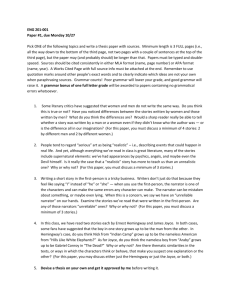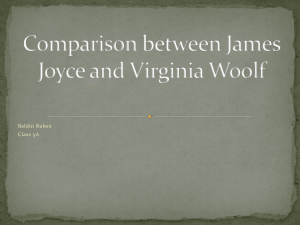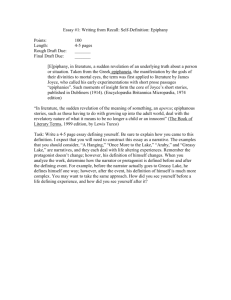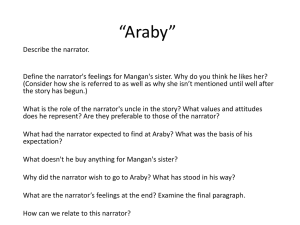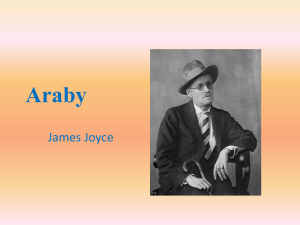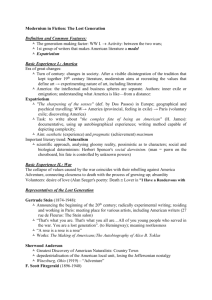Johnny Depp EWRT 1B M/W 10:00am 4/12/12 Hope: Different
advertisement
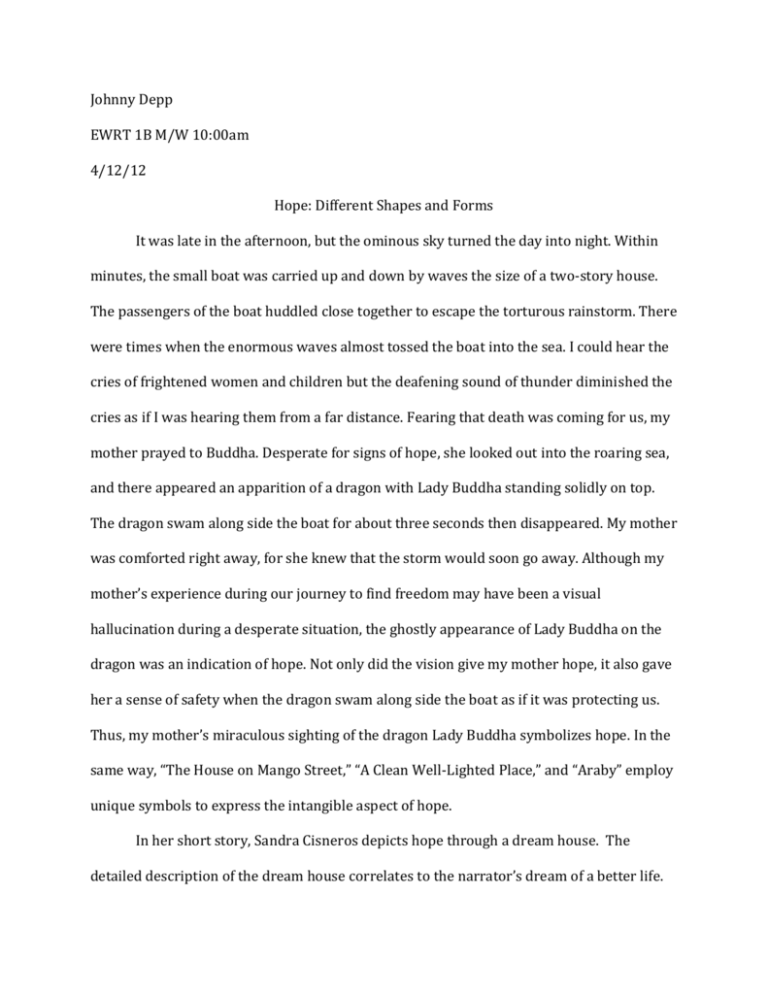
Johnny Depp EWRT 1B M/W 10:00am 4/12/12 Hope: Different Shapes and Forms It was late in the afternoon, but the ominous sky turned the day into night. Within minutes, the small boat was carried up and down by waves the size of a two-story house. The passengers of the boat huddled close together to escape the torturous rainstorm. There were times when the enormous waves almost tossed the boat into the sea. I could hear the cries of frightened women and children but the deafening sound of thunder diminished the cries as if I was hearing them from a far distance. Fearing that death was coming for us, my mother prayed to Buddha. Desperate for signs of hope, she looked out into the roaring sea, and there appeared an apparition of a dragon with Lady Buddha standing solidly on top. The dragon swam along side the boat for about three seconds then disappeared. My mother was comforted right away, for she knew that the storm would soon go away. Although my mother’s experience during our journey to find freedom may have been a visual hallucination during a desperate situation, the ghostly appearance of Lady Buddha on the dragon was an indication of hope. Not only did the vision give my mother hope, it also gave her a sense of safety when the dragon swam along side the boat as if it was protecting us. Thus, my mother’s miraculous sighting of the dragon Lady Buddha symbolizes hope. In the same way, “The House on Mango Street,” “A Clean Well-Lighted Place,” and “Araby” employ unique symbols to express the intangible aspect of hope. In her short story, Sandra Cisneros depicts hope through a dream house. The detailed description of the dream house correlates to the narrator’s dream of a better life. The first image of stairs connotes the hope of upward mobility and opportunity to achieve greater success in life when she says, “it would have real stairs, not hallway stairs, but stairs inside like the houses on T.V.” (Cisneros 127). In contrast to stairs, her dream house would also have a basement, a perfect symbol for a solid foundation and sense of sturdy roots in her life. The narrator continues to state that the dream house “would be white with trees around it, a great big yard and grass growing without a fence” (Cisneros 127). While the stereotypical American dream has a white picket fence, the lack of fence underscores the sense of expansiveness, freedom, and space to move in many directions. The narrator not only wants to break out of the confinement of her own real house, but the confinement of her parents’ poverty that will inevitably suppress any chance for doing, becoming, and having all that she wants. The image of trees and grass growing gives a sense of fertility, growth, and fruitfulness – all aspects the narrator, as an growing adolescent, seems to be lacking in her current life, which clearly is not providing her with the metaphorical sunshine and water needed to thrive. While the narrator’s last line in the story, “I know how those things go,” implies that she is losing hope that her parents will get the house they want, her own ambition is inspired. “I knew I had to have a house. A real house”(Cisneros 128). The reader sees her more driven and determined than ever. Perhaps she is losing hope in her parents’ ability to get this house, but her own hope and desire is ignited through the dream of the white dream house. While Cisneros focuses on a house, Joyce and Hemingway use light as a symbol of hope. In “Araby,” the reader sees moments of light shining amidst the description of the dark neighborhood to create a sense of hopeful optimism against the somber and depressing Irish town. While the houses and streets are described with words like “cold,” “brown,” “imperturbable,” “dark muddy,” “dark dripping,” and “dark odorous,” light appears to be emanating from the playing children as their “bodies glowed” (Joyce 91). The reader can almost see the joy and innocent optimism still in the young people as they shine like fireflies in the night. Unlike the adults in the short story, like the narrator’s numbed out drunk uncle or dismissive aunt, the children have not yet grown cynical and jaded by life. We continue to see hopeful images of light shining on the figure of Mangan’s sister as “her figure [is] defined by the light from the half opened door” (Joyce 91) and later “[t]he light from the lamp opposite our door caught the white curve of her neck, lit up her hair that rested there and, falling, lit up the hand upon the railing” (Joyce 92). The innocent and overwhelming feelings the narrator has for Mangan’s sister are full of hope and promise. As a young boy, life holds exciting potential and adventures until, of course, in the end when he realizes that he is being foolish in his hope that Mangan’s sister might have any interest in him. “[T]he light was out . The upper part of the hall was now completely dark” (Joyce 95). Ironically, as the narrator sees reality clearly, he “gaz[es] up into the darkness”(Joyce 95). His transition from hopeful youth is now complete, and we feel sad at the loss of his light and his innocence. Much like Joyce, Hemingway also expresses hope by using sparks of light against the darkness of the night in “A Clean, Well-Lighted Place.” Hemingway begins his story with an image of darkness as symbolic of hopelessness and despair as the old man, who has tried to commit suicide, sits “in the shadows the leaves of the tree made against the electric light” (Hemingway 96). While the old man has lost all meaning in life, he desperately attempts to get some hope and comfort by going to the well-lit café. The older waiter has compassion for and understanding of the old man’s pain as the narrator states, “It was a nothing that he knew too well. It was all a nothing and a man was nothing too. It was only that and light was all it needed and a certain cleanness and order” (Hemingway 98). The light, even if artificial, provides some comfort in the night of emptiness, despair, and a sense of nihilism. Only with daylight, can the older waiter even go to sleep. The young people in the story are all still full of hope and optimism in life. “The street light shone on the brass number on [the young soldier’s] collar” (Hemingway 96) and the young waiter states, “I have all confidence. I am all confidence” (Hemingway 97). Just like in “Araby,” hope and light seem to be inextricably linked to youth and vitality. In all three stories, hope is symbolically illustrated through concrete images and gives each character meaning, purpose, and an optimism that things will be ok. We, as humans, seem to need hope in our lives to keep going just like my mother’s experience at sea. Hope gave her consolation and the desire and will to survive. Hope comes in many different shapes and forms - a house, light, or Lady Buddha, but in any way it comes, it seems the very essence of our sense of well-being. Works Cited Abcarian, Richard, and Marvin Klotz, eds. Literature: The Human Experience. Shorter 9th ed. Boston: Bedford/St. Martin’s, 2007. Print. Cisneros, Sandra. “The House on Mango Street.” Abcarian and Klotz 127-128. Hemingway, Ernest. “A Clean, Well-Lighted Place.” Abcarian and Klotz 96-99. Joyce, James. “Araby.” Abcarian and Klotz 91-95.
